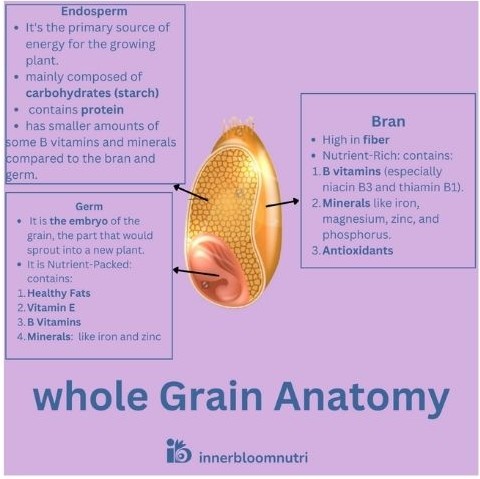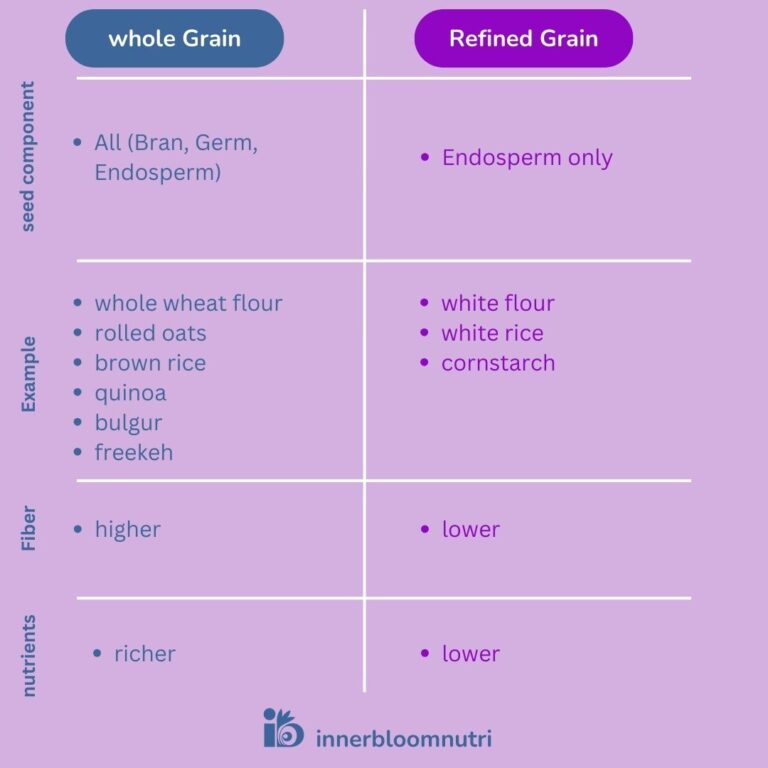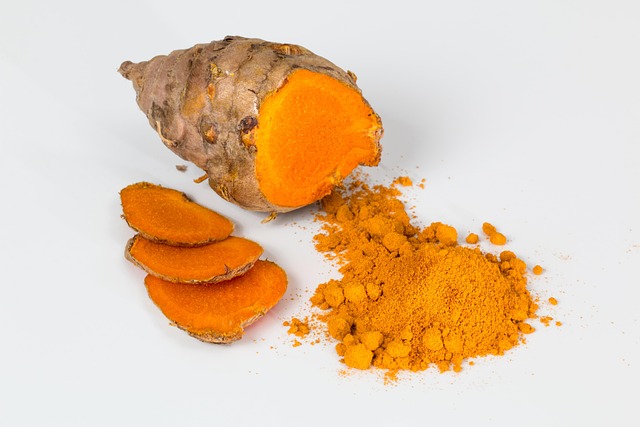Looking for a simple way to boost your health? Whole grains are nutritional powerhouses packed with essential nutrients. We’ll explore what they are, their benefits, how they differ from refined grains, and the variety of types available.
What are Whole Grains?
Whole grains are the complete seed of a plant, containing all three key components: the bran, germ, and endosperm. Each component contributes unique nutritional value.

- Bran: The outer layer, rich in fiber, B vitamins, minerals (like iron and magnesium), and antioxidants.
- Germ: The embryo of the seed, packed with healthy fats, vitamin E, B vitamins, minerals, and antioxidants.
- Endosperm: The largest part, primarily composed of carbohydrates (mostly starch), but also containing some protein, vitamins, and minerals.
Why are Whole Grains Preferred Over Refined Grains?
When a grain is refined, the bran and germ are removed, leaving only the endosperm. This process strips away many of the grain’s nutrients, including most of the fiber, a significant portion of the vitamins and minerals, and the healthy fats. The result is a product that is primarily starch.
That’s why whole grains are so much more nutritious! For example, 100g of whole wheat bread contains approximately 6g of fiber(2), while 100g of white bread contains approximately 2.4g of fiber(3). This difference in fiber content has a significant impact on health.

Why to choose Whole Grains ?
The abundance of nutrients in whole grains translates to a wide range of health benefits:(4) (5)
- Digestion: The high fiber content in whole grains adds bulk to stool, promoting regular bowel movements and preventing constipation. Fiber also acts as a prebiotic, feeding the beneficial bacteria in your gut.
- Blood Sugar Control: Fiber slows down the absorption of sugar into the bloodstream, preventing spikes in blood sugar levels. Whole grains generally have a lower glycemic index (GI) than refined grains, making them a better choice for people with or at risk of type 2 diabetes.
- Heart Health: Whole grains can lower cholesterol levels. Soluble fiber binds with cholesterol in the digestive tract, reducing its absorption. The antioxidants in whole grains also help protect against heart disease by reducing inflammation and preventing damage to blood vessels. Studies have shown that consuming whole grains can lower LDL cholesterol.
- Satiety: The fiber in whole grains helps you feel full and satisfied for longer, which can be beneficial for weight management. This feeling of fullness can help reduce overall calorie intake.
- Gut Health: The fiber in whole grains acts as a prebiotic, nourishing the beneficial bacteria in your gut. A healthy gut microbiome plays a crucial role in digestion, nutrient absorption, immune function, and even mental health by influencing the gut-brain axis.
- Lower Risk of Chronic Diseases: Studies link whole grain consumption to a reduced risk of several chronic diseases, including:
- Heart disease
- Type 2 diabetes
- Certain cancers (especially colorectal cancer)
- Stroke
What are the types of Whole Grains?
There’s a wide variety of whole grains to choose from, each with its own unique flavor and texture:
- Common Grains: Brown rice, whole wheat,corn (whole corn and whole cornmeal), oats, barley, rye
- Ancient Grains: Quinoa, amaranth, farro, spelt.
- Gluten-Free Grains: Brown rice, quinoa, oats (make sure they are certified gluten-free), buckwheat. Oats themselves do not contain gluten, but they are often processed in facilities that also handle wheat, barley, and rye. Therefore, it’s essential to choose certified gluten-free oats if you have celiac disease or gluten sensitivity.
Don’t be intimidated by the variety! Start gradually replacing refined grains with whole grain alternatives in your meals. Experiment with different types to discover your favorites.
Here are some ideas to get you started:
- Baking: Use whole wheat or oat flour in place of refined flour in your favorite recipes.
- Side Dishes: Swap out white rice for brown rice, bulgur, or farro.
- Soups and Salads: Add barley, quinoa, or wild rice to your soups and salads for extra flavor and nutrition.
The key is to have fun exploring the world of whole grains and finding delicious ways to incorporate them into your diet!
The USDA Dietary Guidelines recommend that at least half of our grain intake should come from whole grains, meaning three out of six daily grain servings should be whole. Aim to replace refined grains with whole grains whenever possible, focusing on making at least half of your grain intake whole grains. While it’s not necessary to completely eliminate refined grains from your diet, prioritizing whole grains is key to maximizing their health benefits. Start incorporating more whole grains into your diet today and experience the positive impact on your health.

